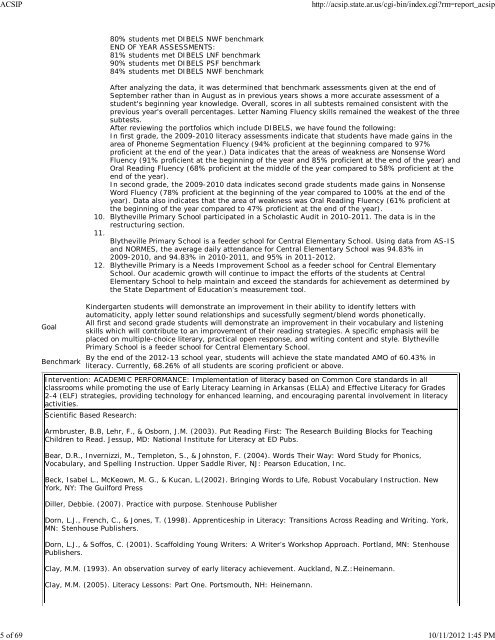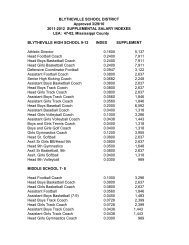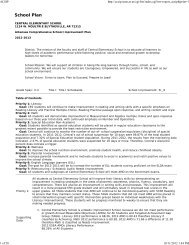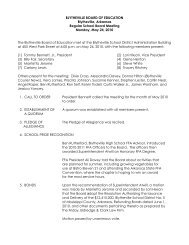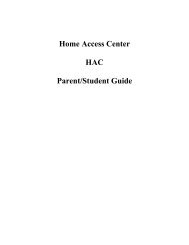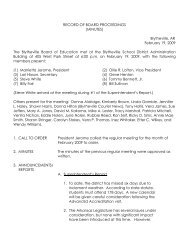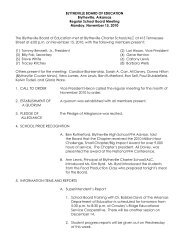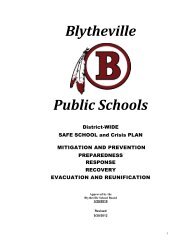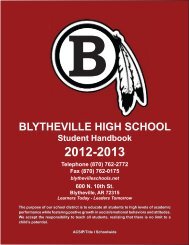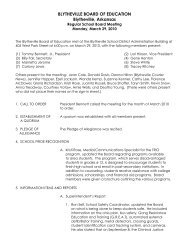School Plan - Blytheville Public Schools
School Plan - Blytheville Public Schools
School Plan - Blytheville Public Schools
You also want an ePaper? Increase the reach of your titles
YUMPU automatically turns print PDFs into web optimized ePapers that Google loves.
ACSIP http://acsip.state.ar.us/cgi-bin/index.cgi?rm=report_acsip<br />
Goal<br />
Benchmark<br />
10.<br />
11.<br />
12.<br />
80% students met DIBELS NWF benchmark<br />
END OF YEAR ASSESSMENTS:<br />
81% students met DIBELS LNF benchmark<br />
90% students met DIBELS PSF benchmark<br />
84% students met DIBELS NWF benchmark<br />
After analyzing the data, it was determined that benchmark assessments given at the end of<br />
September rather than in August as in previous years shows a more accurate assessment of a<br />
student's beginning year knowledge. Overall, scores in all subtests remained consistent with the<br />
previous year's overall percentages. Letter Naming Fluency skills remained the weakest of the three<br />
subtests.<br />
After reviewing the portfolios which include DIBELS, we have found the following:<br />
In first grade, the 2009-2010 literacy assessments indicate that students have made gains in the<br />
area of Phoneme Segmentation Fluency (94% proficient at the beginning compared to 97%<br />
proficient at the end of the year.) Data indicates that the areas of weakness are Nonsense Word<br />
Fluency (91% proficient at the beginning of the year and 85% proficient at the end of the year) and<br />
Oral Reading Fluency (68% proficient at the middle of the year compared to 58% proficient at the<br />
end of the year).<br />
In second grade, the 2009-2010 data indicates second grade students made gains in Nonsense<br />
Word Fluency (78% proficient at the beginning of the year compared to 100% at the end of the<br />
year). Data also indicates that the area of weakness was Oral Reading Fluency (61% proficient at<br />
the beginning of the year compared to 47% proficient at the end of the year).<br />
<strong>Blytheville</strong> Primary <strong>School</strong> participated in a Scholastic Audit in 2010-2011. The data is in the<br />
restructuring section.<br />
<strong>Blytheville</strong> Primary <strong>School</strong> is a feeder school for Central Elementary <strong>School</strong>. Using data from AS-IS<br />
and NORMES, the average daily attendance for Central Elementary <strong>School</strong> was 94.83% in<br />
2009-2010, and 94.83% in 2010-2011, and 95% in 2011-2012.<br />
<strong>Blytheville</strong> Primary is a Needs Improvement <strong>School</strong> as a feeder school for Central Elementary<br />
<strong>School</strong>. Our academic growth will continue to impact the efforts of the students at Central<br />
Elementary <strong>School</strong> to help maintain and exceed the standards for achievement as determined by<br />
the State Department of Education’s measurement tool.<br />
Kindergarten students will demonstrate an improvement in their ability to identify letters with<br />
automaticity, apply letter sound relationships and sucessfully segment/blend words phonetically.<br />
All first and second grade students will demonstrate an improvement in their vocabulary and listening<br />
skills which will contribute to an improvement of their reading strategies. A specific emphasis will be<br />
placed on multiple-choice literary, practical open response, and writing content and style. <strong>Blytheville</strong><br />
Primary <strong>School</strong> is a feeder school for Central Elementary <strong>School</strong>.<br />
By the end of the 2012-13 school year, students will achieve the state mandated AMO of 60.43% in<br />
literacy. Currently, 68.26% of all students are scoring proficient or above.<br />
Intervention: ACADEMIC PERFORMANCE: Implementation of literacy based on Common Core standards in all<br />
classrooms while promoting the use of Early Literacy Learning in Arkansas (ELLA) and Effective Literacy for Grades<br />
2-4 (ELF) strategies, providing technology for enhanced learning, and encouraging parental involvement in literacy<br />
activities.<br />
Scientific Based Research:<br />
Armbruster, B.B, Lehr, F., & Osborn, J.M. (2003). Put Reading First: The Research Building Blocks for Teaching<br />
Children to Read. Jessup, MD: National Institute for Literacy at ED Pubs.<br />
Bear, D.R., Invernizzi, M., Templeton, S., & Johnston, F. (2004). Words Their Way: Word Study for Phonics,<br />
Vocabulary, and Spelling Instruction. Upper Saddle River, NJ: Pearson Education, Inc.<br />
Beck, Isabel L., McKeown, M. G., & Kucan, L.(2002). Bringing Words to Life, Robust Vocabulary Instruction. New<br />
York, NY: The Guilford Press<br />
Diller, Debbie. (2007). Practice with purpose. Stenhouse Publisher<br />
Dorn, L.J., French, C., & Jones, T. (1998). Apprenticeship in Literacy: Transitions Across Reading and Writing. York,<br />
MN: Stenhouse Publishers.<br />
Dorn, L.J., & Soffos, C. (2001). Scaffolding Young Writers: A Writer’s Workshop Approach. Portland, MN: Stenhouse<br />
Publishers.<br />
Clay, M.M. (1993). An observation survey of early literacy achievement. Auckland, N.Z.:Heinemann.<br />
Clay, M.M. (2005). Literacy Lessons: Part One. Portsmouth, NH: Heinemann.<br />
5 of 69 10/11/2012 1:45 PM


